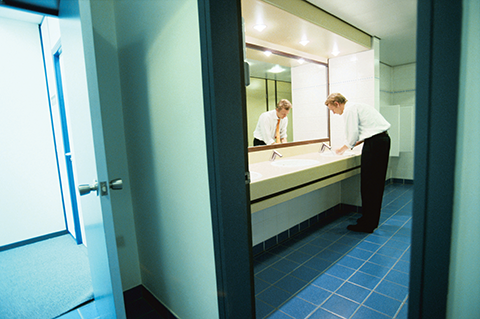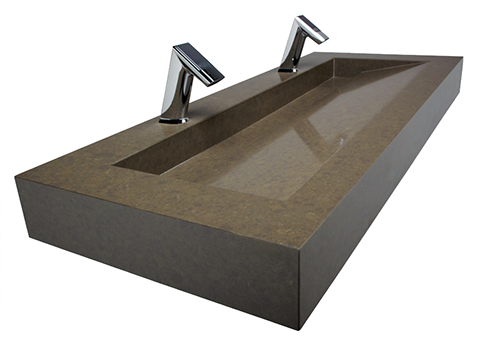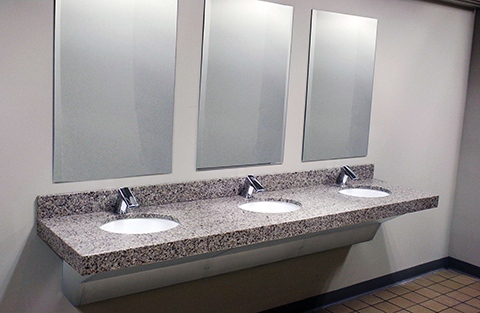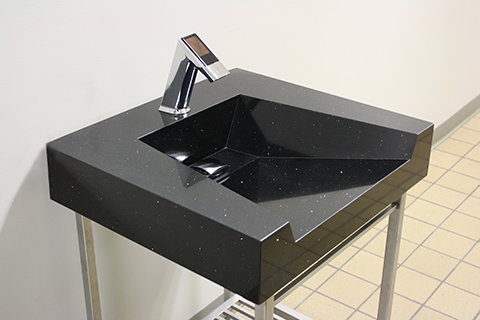Specifying multi-function solid-surface sinks
by Katie Daniel | May 8, 2015 10:07 am
 [1]
[1]by Steve Connaughton
Of the vast amount of plumbing fixtures and accessories it takes to design a commercial restroom, one may not think sinks would require much attention. But, if sinks are not planned as thoroughly as the other plumbing criteria, designers may find the chosen assembly does not properly meet needs, or code, causing costly replacement or changes.
Although there is a large range of sink materials available, solid-surfacing is among the ideal choices for commercial restroom spaces. However, it is more than specifying the material and color selection—navigating through the wide array of commercial sink options can be challenging. Plumbing design innovations have extended the variety of choices enabling specifiers, designers, and engineers to integrate sinks, backsplashes, and countertops with alternative plumbing solutions that complement current design trends without falling back on an ‘institutional’ appearance.
In the past, solid-surface sink platforms have successfully integrated faucets and soap-dispensers. However, the newest restroom sink options now incorporate hand-drying. So, while now matching water-efficient and durable electronic faucets and sensor soap dispensers, these newer models pull deck-mounted hand-dryers into the vandal-resistant sink that stand up to high-use commercial applications. This creates a complete platform to accomplish unique design goals.
Design flexibility of the sink platform is further maximized when narrowing the distance between hand-washing and drying—keeping hand hygiene localized to the sink, with smooth transitions flowing between soap dispenser, faucet, and hand-dryer.
Additionally, first impressions count, especially in a restroom. According to one report, 50 percent of those who visit restaurants said they would tell friends and family about a negative experience with an unclean or unsanitary restroom.
Psychologists have long known the importance of first impressions in a user experience. The restroom is, perhaps, often overlooked as the room that delivers the most significant impact for impressions—which is exactly what the multi-function sinks address.
 [2]
[2]With numerous options to consider, specifying the right solid-surface sink combination can be challenging. Selecting a new sink system—whether a traditional solid surface, or multi-function solid surface—really boils down to five basic differentiators:
- restroom traffic;
- configuration/size (e.g. single or multi-bowl overall size);
- installation and maintenance considerations (e.g. how it is installed and fixed into the countertop);
- integral platform (e.g. integrating soap dispenser/faucet/hand dryer); and
- accessibility.
Restroom traffic
Ultimately, the deciding factor in specifying the right sink is performance, and identifying restroom traffic is the first step in determining what system will best deliver. Restroom usage can be classified under two basic traffic patterns: high-traffic and low-traffic.
In high-traffic situations (e.g. airports and sports stadiums), vandal-resistant, durable fixtures are a must, whereas low-traffic situations can benefit from a more residential style such as pedestal sinks and gooseneck faucets. However, more information about a specific application is needed to influence the optimal choice.
The combination of faucet, soap, and drying into a single station offers different considerations when considering traffic patterns. Typically, dryers (or paper towels) have been set apart from the sink, which can potentially create congestion in a restroom.
In observational instances, one can see people’s behavior as an inconsistent pattern. For example, occupants could be seen leaving a restroom without washing their hands; others may wash, but frustrated by the absence of a full paper-towel dispenser, use their clothes to dry, or shake-off their hands putting water on the floor, potentially creating
a slippery surface.
The new sinks put the tools for proper hygiene in front of the user, making it convenient for hygienic hand-washing to take place. Such considerations, of course, depend on the facility itself. At times, the specifier may consider combining one or two of these new units with a more traditional approach. In other instances, such as executive suites at a stadium, these new models are a perfect solution to accommodate traffic patterns.
 [3]
[3]Configuration
Each restroom has its own intricacies that call for different sink configurations, and commercial specifiers have many styles from which to choose. Sink systems are either wall-mounted or installed on the floor with a pedestal, or floor-mounted cabinet.
If a restroom has adequate structural support in or behind the wall, sinks may be installed onto the wall using mounting fasteners or brackets. These systems can either be countertop-only models, which expose the basin’s underside and other plumbing components, or incorporated into a complete cabinet hiding these components for security, safety, or aesthetics.
Pedestal sinks, and other styles of vanities resting on the floor, are good for commercial restrooms. Rugged, floor-mounted sink systems can include electronic water fountains with multiple spouts, which are popular in high-use environments. An advantage of a pedestal or free-standing fountain model is they fit in corners and other odd spaces.
Solid-surface sink countertops are typically flat. However, some models have surfaces slightly pitched toward the drain or basin to keep water from pooling on the countertop. Integrated solid-surface basins, which have traditionally been square or round, also come in pitched styles—higher in the front, lower in the back, with or without a rim—which lead to linear drains. Again, the suitability
of these various styles depends on the application.
Installation and maintenance
An installation hindrance with wall-mounted cabinet-style lavatories is they are often heavy and cumbersome, making it necessary to have more than one person carry and hold the unit in place as it is attached to the wall.
Many of the new sink platforms offer ‘plug-and-play’ fixtures for easier installation, upgrades, repairs, and maintenance. One example is found in electronic faucet options such as multiple power-harvesting options that suit each environment’s unique needs. Faucet-spray inserts—multi-laminar spray, full-stream aerated, and full-stream laminar—also offer options to adjust feel and flow rate.
As for ongoing service needs, sink systems provide either above- or below-deck access to serviceable components. Unless below-deck components are exposed, access would require removing the lavatory’s front panels, which can be heavy and may require two people. Further, maintenance on models with below-deck components means service professionals must do the work on their backs or knees.
Solid-surfacing material is easy to maintain. Mild abrasive cleaners are usually sufficient for everyday cleaning, and scouring pads can help remove tougher stains.
Integral platform
Sink platforms that allow for soap dispensers, faucets, and hand-dryers demonstrate the most versatility in customizing the space to fit design criteria—often eliminating the need for wall-mount hand-dryers or paper-towel dispensers.
Sensor faucets or spouts are often the preferred option for commercial restrooms where convenience and appearances matter. They are the best choice for restrooms with high-abuse potential, because they are touch-free. For instance, blade or cross handles on a manual faucet can break with repeated rough use, as can the push-buttons on metering faucets, which users sometimes pound on to run the water.
Although some sensor-activated faucets are too delicate for heavy commercial use, there are numerous low-profile, solid-body models better-suited for these applications, and the touch-free operation reduces the likelihood of hands-on damage. Sensor activation also keeps restroom visitors from using water unnecessarily and minimizes the possibility of sink overflows.
Adding a deck-mounted hand-dyer to the sink platform can improve restroom cleanliness, as well as create a more efficient hygiene pattern. Applying soap, washing, and drying hands can be done in one area without affecting traffic flow. Touch-free operation reduces the risk of germs and cross-contamination during the washing process.
Accessibility
Accessibility is a key issue to consider when specifying a sink system. Wall-mounted sink systems are often specified because wheelchairs can slide beneath them. Floor-mounted cabinets can be suitable for wheelchair users if they are contoured to provide enough clearance to allow wheelchair users to get close to the sink.
Applicable plumbing codes to ensure sinks are mounted at the right height and with a suitable reach distance to the faucet for disabled users should be consulted. According to American with Disabilities Act (ADA) guidelines, 865 mm (34 in.) of space is the maximum required above the finish floor or ground to the front of the higher of the rim or counter surface.
 [4]
[4]How to specify
When specifying these new faucet-soap-dryer models (after considering facility type and restroom patterns), specifiers should focus on the need for durability and design. When both durability and the design are part of the restroom’s objectives, this new option presents itself as a viable alternative to traditional separate functionality solutions.
In a best-case scenario, such a combination unit would be available from one manufacturer. Ideally there would be options in each category to choose from to meet any application. However, if the criteria go beyond each category, then a custom specification may be necessary.
Some considerations for the project specification include:
- ergonomic hand-washing basin available in single-, double-, and triple-user stations;
- sink must enable point-of-use sensor operations for faucets, soap dispensers, and deck-mount hand-dryers; and
- material should be stain-, chemical-, scratch-, and impact-resistant.
In addition to the overall sink itself, the specifier should consider the following requirements for faucets:
- demonstrate interchangeability of components to simplify orders, upgrades, repairs, and maintenance;
- offer multiple power-harvesting options to suit the environment’s unique needs;
- provide multi-laminar spray—full-stream aerated or full-stream laminar—with adjustability flow rates as an option; and
- include a line purge function to eliminate the stagnant water that can lead to bacterial growth.
Electrical specifications should include:
- control circuit: 6.75 volts direct current (VDC);
- sensor range–factory setting: 102 to 127 mm (4 to 5 in.);
- battery life: five-years under worst-case conditions of 8000 cycles/month and high water pressure without power-harvesting which should extend service life of battery; and
- nominal range adjustment: 51 to 356 mm (2 to 14 in.) nominal;
- power supplies: 6 VDC alkaline battery pack.
While not necessarily the specifier’s responsibility, consideration should be given to warranty on these new multi-function sinks. The better the warranty, the more confident the manufacturer is in the product’s performance over a minimum of three years. Of course, the sinks must also meet the applicable codes and standards, which include:
- American Society of Mechanical Engineers (ASME) A112.18.1/CSA B125.1, Plumbing Supply Fittings;
- NSF 372, Drinking Water System Components–Lead Content;
- ANSI/Underwriters Laboratories (UL) 1951, Standard for Safety–Electric Plumbing Accessories;
- International Code Council/American National Standards Institute (ICC/ANSI) 117.1, Accessible and Usable Buildings and Facilities;
- UL 499, Standard for Electric Heating Appliances;
- UL 507, Standard for Electric Fans;
- International Association of Plumbing and Mechanical Officials (IAPMO) Guide Criteria (IGC) 156, Wash Fountains And Lavatory Systems With or Without Water Closet; and
- IGC 127, Combined Hand-Washing Systems.
When applicable, specifiers and design teams should also be aware of:
- Uniform Plumbing Code (UPC);
- International Plumbing Code (IPC);
- California Green Building Code (CALGreen); and
- City of Los Angeles Water Efficiency Ordinance.
Legislative compliance is important as well, which includes the Federal Reduction of Lead in Drinking Water Act, Law 111-380 (i.e. contains no more than 0.25 percent weighted average lead content), Section 116875 of the California Health and Safety Code, and Vermont Lead Reduction Law.
From a plumbing perspective, specifying commercial sink systems is not as easy as it used to be. However, this is a good thing, because it brings more options to specifiers and project teams. There are many factors to consider, and there are more choices in integrated technologies and fixtures than ever before, and the sheer breadth of options can be daunting. Keeping the basic issues in mind can help the specifier make a clear choice.
Steve Connaughton is the sink system and programmed water technologies (PWT) product line manager for Sloan Valve Company. For more than 30 years, he has worked in numerous sales and management capacities for Sloan. Connaughton can be reached at steve.connaughton@sloanvalve.com.
- [Image]: http://www.constructionspecifier.com/wp-content/uploads/2015/05/sink_Office02.png
- [Image]: http://www.constructionspecifier.com/wp-content/uploads/2015/05/sink_Designer-Series-DSG-2-station-with-BASYS.png
- [Image]: http://www.constructionspecifier.com/wp-content/uploads/2015/05/sink_WallMountSloanStone.png
- [Image]: http://www.constructionspecifier.com/wp-content/uploads/2015/05/sink_SmallBlackSink1.png
Source URL: https://www.constructionspecifier.com/specifying-multi-function-solid-surface-sinks/